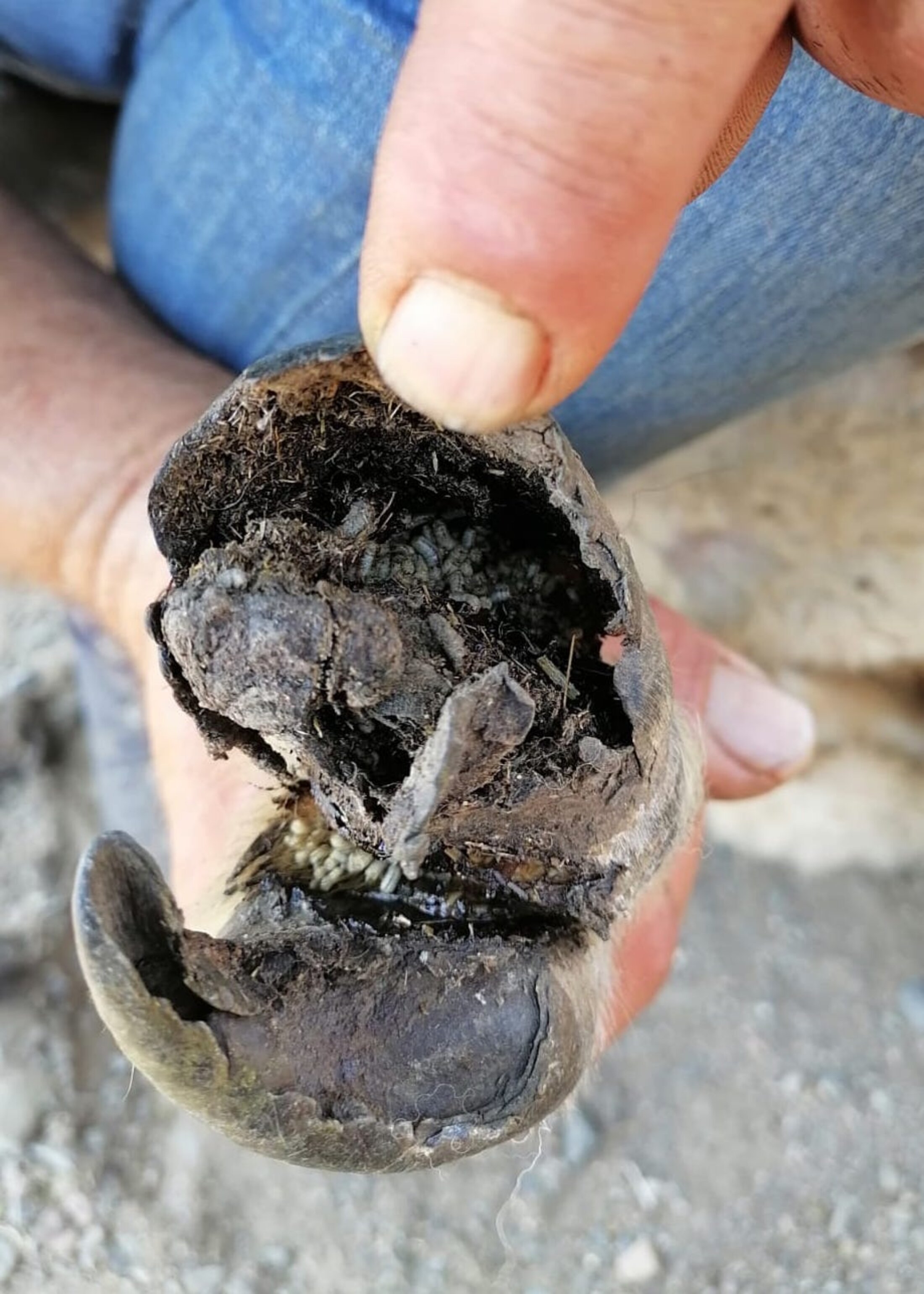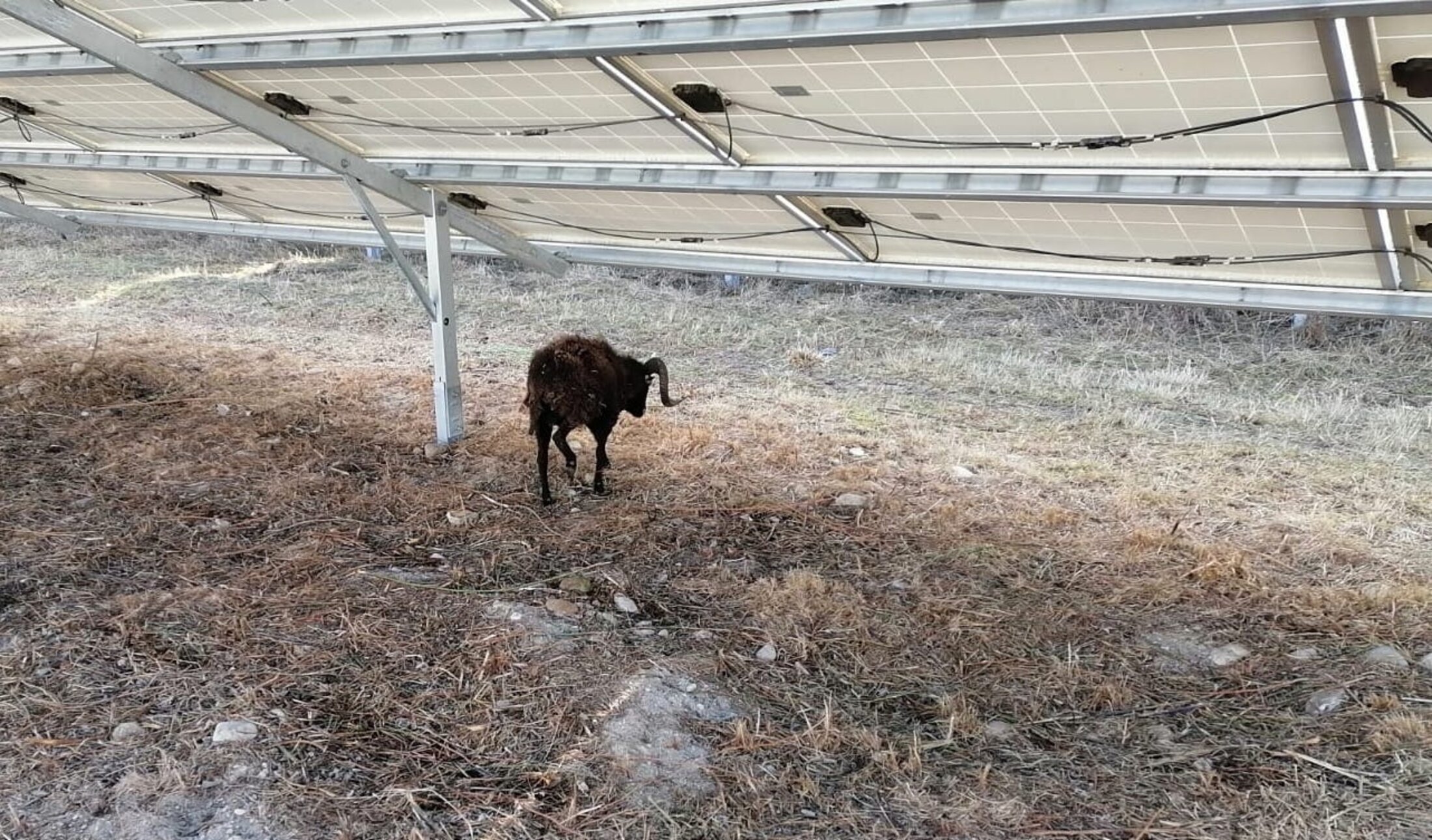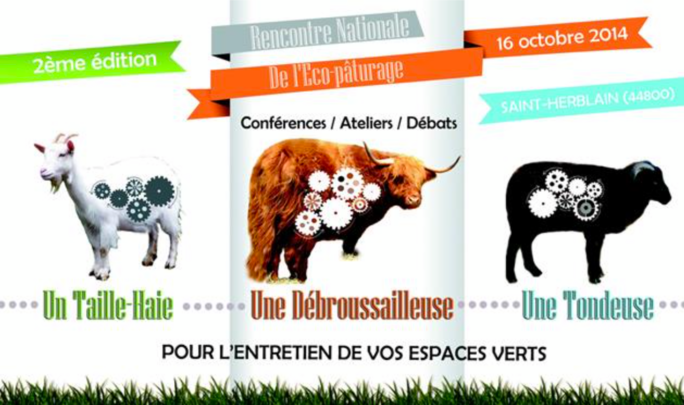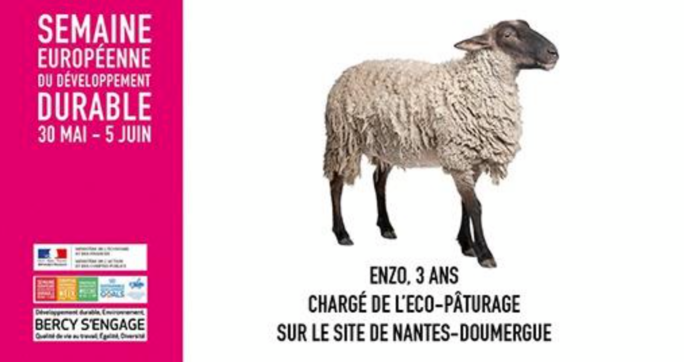It all began with a man who was passionate about ornithology and who was seeing birds disappearing in front of his eyes. “Even twenty-five years ago naturalists were warning about the extinction of species and I wanted to do something,” recalls landscape architect Alain Divo. He had an eco-friendly idea: to do away with machinery to cut the grass and instead use animals to look after green spaces. “As they don't eat everything, it preserves some biodiversity,” he explains. The first results proved conclusive: a number of plants grew back and with them returned insects and even some bird species. But this was the start of the 2000s and the idea failed to take hold.
Then the landscaper and entrepreneur had a new idea: to come up with a catchy phrase in order to market the idea better. Thus the concept of 'écopâturage' – usually known as 'eco-grazing' in English – was born. Alain Divo registered this as a brand on France's intellectual property register the Institut National de la Propriété Industrielle in 2012. With this attractive repackaging he then planned to roll out this new approach to mowing grass across France. “That's how it began,” he says. A little over ten years later eco-grazing is now a flourishing business.
The sector's main professional network, 'Animal et Cite', had 27 companies providing eco-grazing services on its list in 2014. It now has 400 companies. In total there are around 4,000 eco-grazing sites across France, according to this trade body, though it does not have an exhaustive list. From French oil giant TotalEnergies to Amazon, and including local councils of all sizes, nuclear power plants and solar energy farms, everyone wants to deploy sheep to replace noisy and polluting lawnmowers.
Geographer Corinne Eychenne is a specialist in pastoralism at the University of Toulouse and has studied the issue. “A real market has emerged over the last ten or so years,” she says. “The desire for it comes against a backdrop of regulation which bans chemical products in the maintenance of green spaces and, more generally, of a wish to 'get back to nature'”.
On paper there are only upsides. “Ecological mowing is less noisy, cheaper and more sustainable,” boasts one of the market leaders Ecomouton. “Sheep are discreet: they eat and they sleep.” There is no “disturbance”. It is the best form of 'greenwashing' even though the environmental benefits are as yet not well documented.
Ecomouton was created in 2012 by the manager of a logistics depot and has grown fast. It raised a lot of capital, and since then its turnover has enjoyed double-digit growth, passing the million euro mark in 2017, since when it has doubled. The company now runs a flock of nearly 6,000 sheep spread over around 500 sites across France. It charges its clients between 3,000 and 6,000 euros per hectare (2.47 acres) grazed each year. It is a profitable business plan but behind the scenes the reality is not quite so great, according to some current and former staff who have spoken to Mediapart.
Corpses on the grass
“New sites are starting virtually every week and hundreds of sheep are left in fields with no one looking over them and getting no more attention than a lawnmower,” says B., a worker who like others who spoke to Mediapart wants to remain anonymous.
In fact, each Ecomouton site is run by a 'shepherd' whose job involves visiting twice a month to count the sheep, and to check the fencing and the water and food supply in the fields. Some do the work as a side business to earn an extra 100 or 150 euros a month. Others look after several sites – in some cases as many as 40, according to Mediapart's information - and work full-time. Neither the law nor the company require any training in order to be qualified in 'eco-grazing'. S., who took up a post recently, says: “The word 'shepherd' is just there for marketing. According to our contracts we're 'landscape workers'.”
Sylvain Girard, the owner of Ecomouton, says: “Most of our shepherds are livestock professionals who do it alongside their farming activities, we're looking for people with experience.” Yet some of the workers to whom Mediapart has spoken were novices. “I'd never done that before I started, I didn't know how to go about herding the sheep to count them. You have to know a billion things to understand what's going on in the heads of a flock, I was overwhelmed,” admits new shepherd S.

Enlargement : Illustration 1

“I've seen corpses strewn over sites, sick flocks, sites with too many animals without feed in the winter or water in the summer,” says T., a former shepherd. “I sometimes had to pay for fodder for hungry animals myself. How the system works is that the sheep eat to fulfil the maintenance contract and those that survive produce young to renew the flock,” she says.
For example, the mandatory declarations about births and deaths for one site occupied at any one time by 190 'eco-sheep' show that there have been 240 deaths there since 2018. “That figure is four or five times over the average,” says Bastien Boyer, who works for Bergerie Urbaine, a city farm organisation in the eastern city of Lyon. During that same period 200 lambs were born. “They had a lot of births to make up for the losses,” notes the former shepherd.
In another département or county in France more than 200 dead sheep were recorded over three-and-a-half years in a flock that is typically around 70 in number at any one time. Overall that is equivalent to almost the entire flock being wiped out each year. The body in charge of overseeing animal welfare in that département – the Direction Départementale de la Protection des Populations (DDPP) – and which also oversees eco-grazing explained that these excess deaths came from “recurring attacks by dogs and by animals escaping because of the poor state of fencing which has since been repaired”.

Enlargement : Illustration 2

At another site the morality rate is above 40%. This time it seems that illness is the cause. Some failures in obligatory health measures were picked up in 2021 by the local DDPP which also noted that the flock consisted of sheep of many different origins. “The mixture of sheep causes an explosive cocktail of parasites,” notes C., a livestock worker who also works for Ecomouton to top up his wages.
Nor is such a set-up ideal for the sheep either. “They're animals who like to live as a family. As soon as there are changes in the flock, in the available food or even in the size of the land, they're disturbed. And not every location is adapted to every sheep breed,” says Julie Lou Dubreuilh, a shepherd and founder of the association Clinamen, a group which campaigns for small-scale farming in the Seine-Saint-Denis département north of Paris.
For example, Ouessant sheep, the breed mostly used by Ecomouton, are often located far from where they originate, an island of the same name off the coast of Brittany in west France. “It's wrong to have them in Savoie and in Haute-Savoie [editor's note, in the French Alps],” says former employee T.
Guillaume Leterrier, who looks after several Quessant sheep at for an urban shepherd association Les Bergers Urbains at La Courneuve in the northern suburbs of Paris says: “ Even in the Paris region it's difficult. [In this area] we have to give hay to Ouessant sheep because the grass is too rich for this breed. Otherwise they get laminitis, the equivalent of gout, and that's not good for them.”
Retirement home for sheep
“There's a 'sheep business' which has grown up with animals being moved from site to site across France, which puts into perspective the environmental merit of the practice,” says one DDPP official from the Paris region who admits to struggling to keep track of the animals' movements. Data from Ecomouton, seen by Mediapart, reveals that there are transfers of sheep between sites several times a year, sometimes from the north to the south of France.
“That's the eco-grazing job,” says Ecomouton boss Sylvain Girard. “We put the sheep in a field, the sheep need a certain quantity of grass and that varies during the year. We need to put more sheep in during the summer and fewer in winter. So part of the flocks in particular are moved to reserve zones in winter.”
He also gives another explanation, which also serves as justification for the excess deaths at some sites. “When our animals grow old, when they're ill, they die on our land,” says Sylvain Girard. “And we're not going to let them die on eco-grazing in front of a school or a company HQ. So we have some retirement sites far from public view. Sheep live around eight years, and out of our 6,000 animals that means 700 to 800 deaths a year. At one Paris site we never have deaths but if you take a retirement site, 100% of the livestock will die within two years.”
That is the case, for example, with the Luxel solar panel farm at Saint-Cyprien in central France. Here a 'retirement home' for sheep was set up on an industrial waste dump. In 2008 a factory fire there caused pollution from PCBs – hazardous man-made organic chemicals – and various other substances. This worsened the already bad environmental impact of years of industrial use: copper and lead reclamation, the use of heat-stripping to recover metals, the destruction of electric transformers, the crushing of radiators and so on. Farming is banned there but not eco-grazing. “As long as the sheep are not intended for [human] consumption,” says the local DDPP office, and that the animals instead quietly end their days chomping away at a polluted site.
“At photovoltaic sites eco-grazing is a very good option,” says a source at Engie Green, which runs solar panel plants. “It costs less and is more environmental because without the animals you have to spray or put down concrete or use machines, which is wrong when you're producing renewable energy. But we are reflecting on the agri-photovoltaic side, as we're paying for eco-grazing not urban homes for dying sheep.”

Enlargement : Illustration 3

Eating the 'gardeners'
“We're doing nothing wrong, there's nothing secret. If I am growing bigger it's because I'm doing a good job,” says the Ecomouton boss. Sylvain Girard accepts that “human error” is possible and that there had been “accidents” at certain sites, and that a “shortage of rural vets doesn't help”. But he denies any “structural” negligence. “It's a competitive market and we're the market leader, it's natural that we're a target but the abuses occur elsewhere,” he insists, citing a number of “more than problematic” practices among competitors. He adds that they are members of the industry body, the Fédération Française d’Écopâturage, which “sets boundaries in a market that's poorly regulated, not monitored enough and in which some do whatever they want. Not us.”
In the “conquest” of this sheep-mowing market there is indeed a lot of competition. “Some work for very low prices,” explains Sylvain Girard. Others use 'charters' and 'official certificate of eco-grazing' as labels of quality but which are in reality subject to little oversight. A range of different groups and individuals make up the mix of those involved in the sector: livestock farmers, start-ups, professional eco-grazing outfits, landscapers, pioneers from city farms, local associations, activists and so on. “The boundaries between them are sometimes porous,” says academic Corinne Eychenne. “And there are good and bad practices pretty much everywhere. Everyone knows of abuses in the sector and there are inadequate companies, which is not a reason to criticise a practice which is not bad in itself, but the development of eco-grazing does question our relationship with animals.”

Enlargement : Illustration 4

How does one look upon these animals that graze near us? How does that determine their living conditions? At the second national meeting of the eco-grazing conference Rencontres Nationales de l’Écopâturage, organised by the association 'Entretien Nature et Territoire' in 2014, one poster showed 'machine animals' portrayed as 'hedge-cutters' or 'mowers'. A mayor of a town south of Paris took this logic even further and invented a 'moutondeuse' – a combination of the French words for sheep and mower – a form of mobile cage for sheep to graze his town's green spaces with precision. In a different and more anthropomorphic approach, the French Treasury extolled the virtues of “Enzo, aged 3” a sheep who was “in charge of eco-grazing” at the Treasury as part of a public relations campaign by the Ministry of Finance during the European week of sustainable development in 2021.

Enlargement : Illustration 5

“At the most basic level farm animals are animals for profit or products. With eco-grazing there is a third category: the service sheep who are there to mow and provide pleasure,” explains shepherd Julie Lou Dubreuilh. Based in the département or county of Seine-Saint-Denis just to the north of Paris, she campaigns to preserve all aspects of the sheep sector: grazing for landscaping, environmental, social and educational reasons, but also the production of meat, wool, fat and milk. “For example, one of the uses of grazing in town is to make biodiversity more acceptable” she says. “If you leave long grass in an urban park explaining that it's for the sheep, it becomes acceptable, otherwise it's more difficult. But you're not going to pay a shepherd every month for that. Eco-grazing uses the animals in a particular way that isn't profitable on its own if you really take care of the animals on a daily basis.”
Urban shepherd Bastien Boyer from Lyon, says: “If sheep, who emit methane when digesting, are just mowers moved from site to site as required then they pollute for no great benefit. Eco-grazing that doesn't contribute to nutrition is not environmental, it's greenwashing.”
Should one really eat the gardeners so they can be well looked after? And would the general public agree to this? These are questions raised by the geographer Marlène Lagard in an article published in the periodical Études rurales. In it she gives a telling anecdote. In a small town near Nantes in west France sheep were put to graze near a primary school. In the spring some of the lambs were sent to the abattoir and then delivered as organic meat to local school canteens. None of the councillors said a word about the setting up of this local food production network for fear of the reaction from local residents and of protests against eating lamb from the urban farm.
“Paradoxically eco-grazing is based on a negation of livestock farming, placing emphasis on the presence of an idealised animal, one with environmental and social benefits and free of the controversial elements of our relations with animals: death, slaughter, the consumption of animals,” concludes Marlène Lagard. In other words, you don't eat the gardener and they die out of sight under solar panels.
----------------------------------------------------------------------------
- The original French version of this article can be found here.
English version by Michael Streeter
------------------------------------------------------------------------------
If you have information of public interest you would like to pass on to Mediapart for investigation you can contact us at this email address: enquete@mediapart.fr. If you wish to send us documents for our scrutiny via our secure platform SecureDrop please go to this page.


